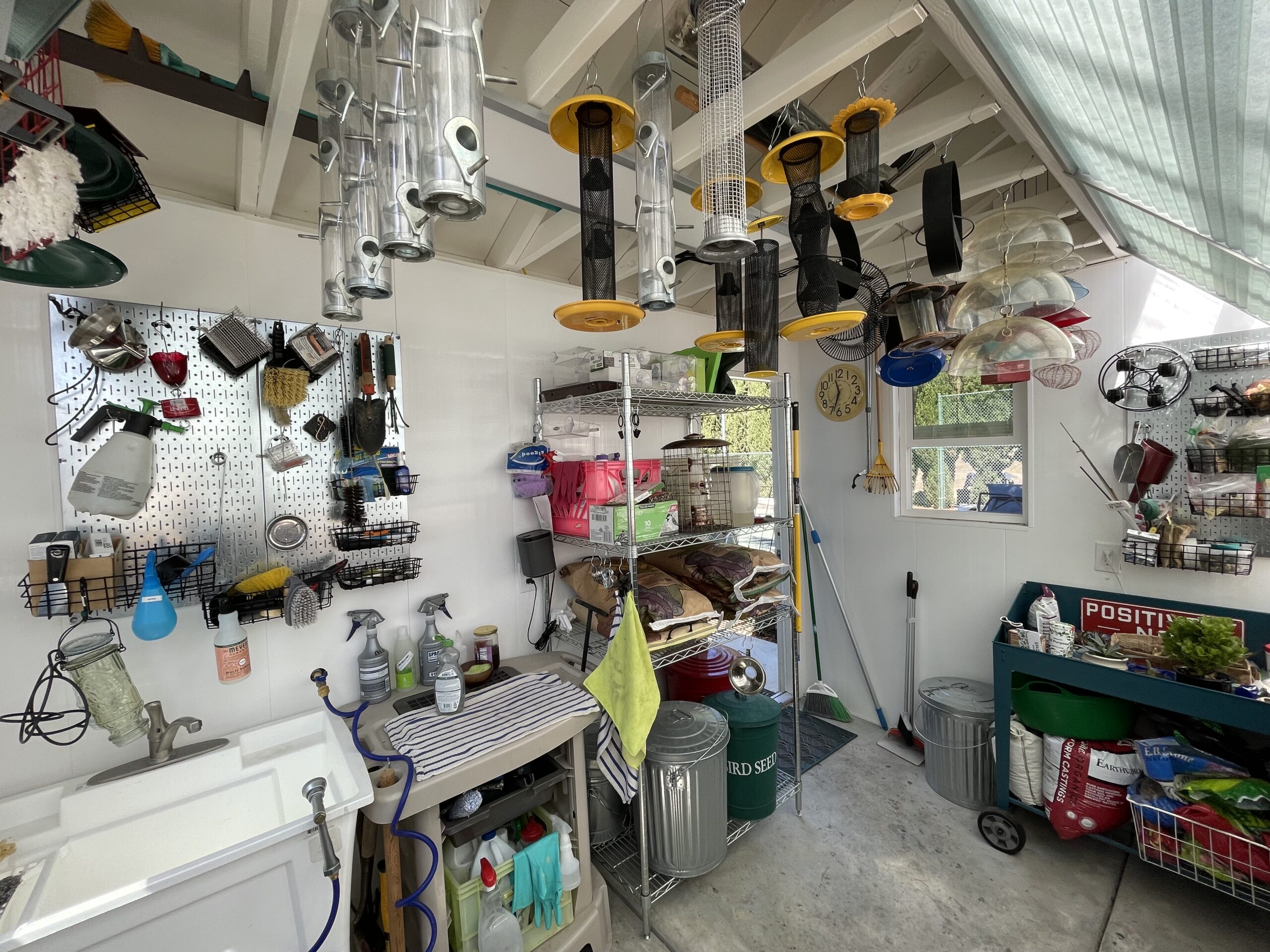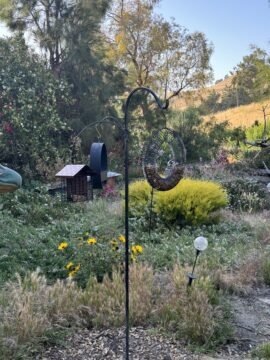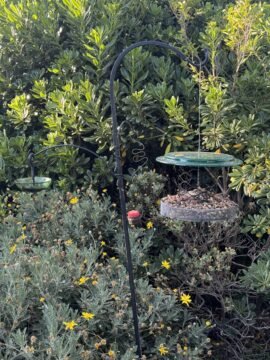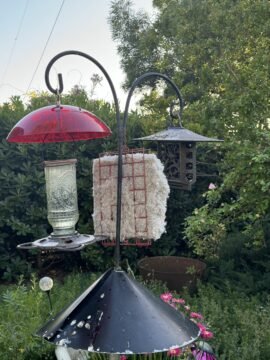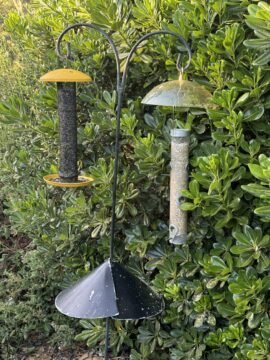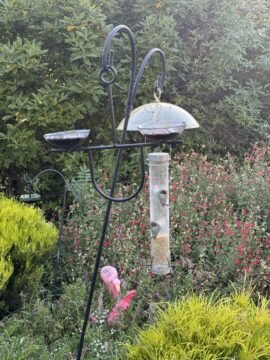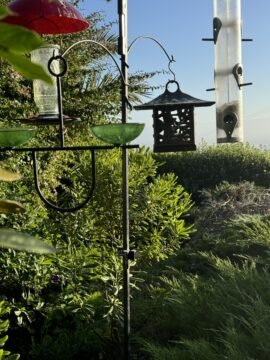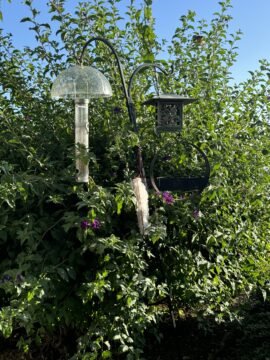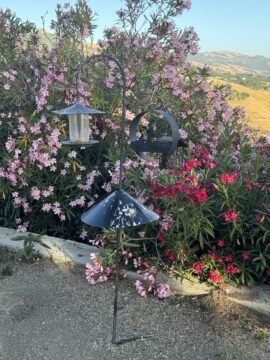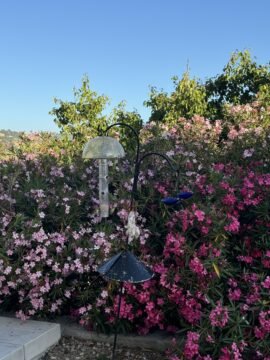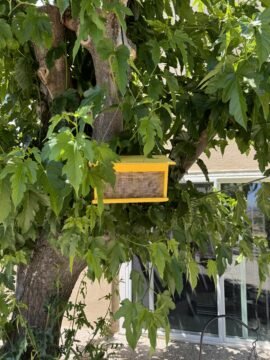We have turned bird feeding into a mini-industry here at Purgatory, although sometimes it borders on an art form as well. With multiple stations that each offer multiple food options, we have been successful in attracting a multitude of birds, while also making sure our family of Fox Squirrels and the bully-birds like our jays leave the smaller species alone. Plus we minimize the chances of a bird with a contagious disease such as Avian Pox or Salmonella from infecting other birds by regularly cleaning things, and in some cases, using add-ons. A lot of people have asked me–especially when they see the inside of the garden shed–which feeders I like or dislike. Thus the idea for this post and the next one was born.
So what makes for a great bird feeder? It depends what sort of bird you want to attract and feed. Here in Northern California, we have lots of different species with different dietary preferences, and so the primary things we dish out are:
- Nyjer, often mixed with small chips of shelled sunflower seeds
- Whole hulled sunflower seeds
- A mix of sunflower, safflower and millet (hulled)
- Dried Meal Worms
- Suet
- Peanuts in the shell
- Sugar Water
- Grape Jelly (March to August)
Here’s a look at the feeding stations we have set up and what sort of birds like which stations. Now there are five Shepard’s hooks in the north garden:
In the gallery above:
- The first image shows the station farthest from the house. That station almost always has a coil peanut feeder, a suet feeder and circular mealworm feeder. It services our jays (Steller’s and California Scrub), Fox Squirrels, Northern Mockingbirds, Yellow-Billed Magpies and many other larger birds.
- The second image shows the station nearest to the largest birdbath, which is also the bath nearest my office window. It has a modified feeder for nuts and a small pot for sugar water, and depending on the season either a jelly dish feeder or suet. The nuts are a favorite of our jays (Steller’s and California Scrub) and Fox Squirrels. During the late spring and summer we put out jam for our orioles, as brooding parents then feed it to their nestlings.
- The third image shows the feeder nearest the house just to the left of the flagstone path. It always has a suet feeder and sugar water feeder, although what style of sugar water feeder varies depending on the season. During the summer months when Bullocks and Hooded Orioles reside here, we switch to a larger port style with perches to accommodate the orioles. The suet is eaten by many species, but woodpeckers, nuthatches and sparrows enjoy it the most, while the sugar water feeder is frequented by hummingbirds and orioles. During the breeding season we hang a fluffy material dispenser, from which birds grab nesting material.
- The fourth image shows the original feeding station that started it all–located to the right of the foot path, it has a nyjer feeder and a simple column seed feeder, along with a squirrel baffle. You probably also notice that the column feeder has an upper baffle as well; I’ll get to why I do that in a bit. Finches and Sparrows, and the occasional towhee and grossbeak like those feeders.
- The fifth image shows the station directly across from the previously-described station, It has a column feeder and another jam feeder, and behind them on a short Shepard’s hook is an additional jam feeder. Once again the finches and sparrows like the column feeder, while the orioles go for the jam. In the winter months we rotate the jam feeder out and add in another seed feeder.
So to expand on the list above, I try to position feeders on the edge of the north garden to entice bullies like the jays, mockingbirds, magpies and arboreal squirrels with stuff they really like. That way they leave the other offerings alone, which means the more peaceful birds like the finches, sparrows and orioles can eat what they prefer, and since hummingbirds are only dicks to other hummingbirds, having a wide variety of options for the dozen or so that live near the house keeps them all happy as well.
Then around the rest of the house garden areas we have a few other setups:
In the gallery above:
- The first image shows the station outside the boys’ space, which always includes a sugar water feeder, a suet feeder and a column feeder. The jam feeder is only used in the later spring and summer months. The rest of the year a variety of things may take its spot.
- The second image shows the station outside the master bedroom. It’s the newest setup as that hook sat under the ancient walnut tree at the wall, but the winter winds meant we didn’t fill the feeders between November and March. Now, in its new spot, it hosts column, suet and mealworm feeders. During the breeding season we hang a fluffy material dispenser, from which birds grab nesting material.
- The third image shows the feeder across from the kitchen. It hosts mealworm, suet and seed feeders.
- Finally, the fourth image shows the station by the garden shed, which always has a sugar water feeder and column seed feeder. In the spring and summer it also hosts a jam feeder.
Then we have a few other offerings sprinkled around the house gardens:
So those are the setups. In the next post, I’ll detail what feeders we really, really like and why.

